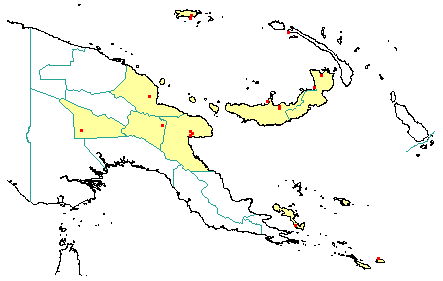
in PNGplants database
PNGTreesKey – Ternstroemia cherryi (F.M.Bailey) Merr. ex F.M.Bailey & C.T.White |
Barry Conn (NSW) & Kipiro Damas (LAE).
Guide to trees of Papua New Guinea
Copyright held by the authors, National Herbarium of New South Wales, and Papua New Guinea National Herbarium
Queensland Department of Agriculture & Stock. Botany Bulletin Vol. 19: 3 (1917)
Other Literature: W.R. Barker, Brunonia 27-32 (1980) Fig. 5.
Family: Pentaphylaceae
Dicotyledon
Timber Group: Non-timber species
Field Characters: Small sub-canopy tree (up to 20 m high, rarely to 25 m); Bole cylindrical (up to 70 cm diam.); straight (bole up to 10 m long) or slightly crooked; buttresses buttresses present (sometimes as low foot buttresses) or buttresses absent; spines spines absent; aerial roots aerial roots absent; stilt roots stilt roots absent; Bark brown or grey, smooth or rough, sometimes scaly or flaky, fissured, or pustular, lenticels rounded/swelling; Subrhytidome (under-bark) green, red, or brown; less than 25 mm thick; bark blaze consisting of one layer; faintly to non-aromatic; outer blaze white, yellow (pale (cream-coloured), red, or brown, with stripes or speckled; inner blaze yellow (pale (cream-coloured), white, red, or brown, with stripes or speckled; bark exudate (sap) present, colourless, not readily flowing (spotty), colour changing on exposure to air, to pale brown or pale red, not sticky; terminal buds not enclosed by leaves.
Indumentum: Complex hairs absent; stinging hairs absent; mature twig indumentum (hairs) absent.
Leaves: Leaves spaced along branches, opposite (in pairs, opposite one another on the branchlet) or whorled (with more than two leaves at one node of a branchlet), 3-5, simple (a leaf composed of a single blade); petiole present, not winged, attached to base of leaf blade, not swollen; leaves broadest above middle or broadest at or near middle, (6.0-) 7.0-16.0 (-20.0) cm, (3.0-) 3.5-8.5 cm; symmetric (to slightly asymmetric), entire, not dissected or lobed, acuminate (shortly) or obtuse, venation pinnate, secondary veins open, prominent, intramarginal veins absent; leaves lower surface pale green, upper surface green, indumentum (hairs) absent; present; domatia absent; stipules absent.
Flowers: Inflorescence axillary (mostly on branchlets below leaves, hence extra-axillary), flowers single, cones absent; flowers unisexual, unisexual with male and female flowers on the same plant, stalked, flowers with many planes of symmetry, 10.0-15.0 mm long, diameter large (more than10 mm diam.) (15-20 mm diam.); perianth present, with distinct sepals and petals whorls, inner perianth white, pale yellow, or cream-coloured; 5, free or at base some or partly joined; stamens 100, present, free of each other, free of the perianth; ovary superior, carpels joined (when more than one), locules 5; styles solitary, 1.
Fruits: Infrutescence single, fruit 30.0 (c.) mm long, 30.0 (c.) mm diam., yellow or dull orange, not spiny, fleshy, simple, indehiscent, berry; seeds 4-(seeds red, mostly 1-2 per locule)-5, much more than 10 mm long (15-20 mm long), not winged, narrow (longer than wide), seed 1-10 mm diam. (c. 10 mm diam.).
Distribution: Madang, Morobe, Eastern Highlands, Southern Highlands, Papuan Islands, New Britain & Manus.
 | Botanical records in PNGplants database |
Notes: Notes Ternstroemia was previously classified in the family Theaceae.